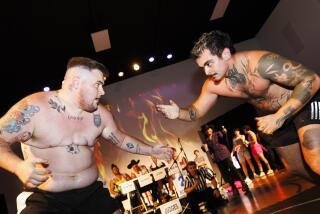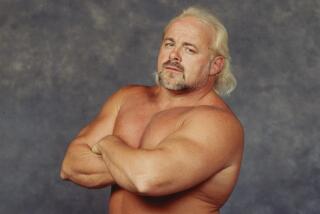AEW debuts as a new hope in pro wrestling
Pro wrestling is a unique form of entertainment. It is built around investing fans in heated verbal battles that lead to physical confrontations, yet collaboration between the wrestlers is central to making it work. The biggest stars of the genre, from Dwayne “The Rock” Johnson and “Nature Boy” Ric Flair to “Macho Man” Randy Savage and “Stone Cold” Steve Austin have larger than life personalities in a way that few celebrities do. It’s also been a long time since this distinctive world has had significant competition in this country.
There were once major professional wrestling companies that covered pretty much every major city from coast to coast across North America. These territories had different flavors. In the Midwest, the American Wrestling Association was built around memorable interviews from the likes of gravelly voiced Maurice “Mad Dog” Vachon and working class hero The Crusher. In the Bay Area, Roy Shire promoted a brand of wrestling built around exciting in ring performers like Ray “The Crippler” Stevens and Pat Patterson. In Dallas, local family dynasty the Von Erichs spent decades chasing the NWA world title from patriarch Fritz through sons David, Kevin and Kerry.
Pro wrestling changed in the 1980s when Vincent K. McMahon (the Vince McMahon you likely know from screaming “you’re fired” at his wrestlers) went national with his father Vincent J. McMahon’s northeast territory. He raided other promotion’s wrestlers and set off a major promotional war with McMahon battling the likes of Verne Gagne’s AWA, Fritz Von Erich’s World Class Championship Wrestling, Bill Watts’ Mid-South Wrestling (later the Universal Wrestling Federation), and Jim Crockett Promotions (which later become WCW).
The 1990s in pro wrestling were defined by the “Monday Night War,” where WWF ran its signature Monday Night Raw show on USA against WCW Monday Nitro on TNT. Paul Heyman also took ECW national, an insurgent counterculture wrestling company that was built around showing defiance towards the behemoth major companies. It’s a time period that is still remembered fondly by wrestling fans.
All that changed abruptly in 2001. WCW was cancelled by TNT and TBS. The company was sold to the then-WWF for pennies on the dollar. ECW, unable to secure a worthwhile television deal of its own, was forced to fold. In a two week period, WWE became the only major American wrestling company. With the exception of a brief and failed challenge from the TNA Impact promotion, no wrestling company has threatened WWE since.
Vince McMahon, who finally attained the dominance he always sought, did not react well to monopoly status. Without anyone challenging him, he gave in to his worst instincts and lost touch with his audience. His stories constantly revolve around authority figures having more power than wrestlers, with the McMahons and the WWE brand itself being framed as the real stars of the show. McMahon makes up his mind on wrestlers, undermining wrestlers fans react well to but that he doesn’t like as much while going strong with wrestlers fans reject. Wrestlers up and down the cards are put in comedy sketches built around McMahon’s unique and often childish sense of humor.
Pro wrestling, historically an extemporaneous art form built around wrestlers having great flexibility to define their own personalities, became tightly scripted. Wrestlers aren’t able to craft their own messages and characters like previous generations and instead deliver the words of writers catering to the now 74-year-old McMahon’s often erratic whims. McMahon has even mounted an aggressive campaign to try to change the way his fans talk, insisting on calling wrestlers “superstars” and calling wrestling “sports entertainment.” Think of the NFL waging a 20-year battle to try to get fans to stop using the word football. Fans aren’t even allowed to be fans; they’re the “WWE Universe” as WWE announcers will remind you 10 times or so every show.
Unsurprisingly, interest in WWE and thus pro wrestling in general has greatly declined since competition went away in 2001. In 1999, WWF Raw set a ratings record when it drew 9.2 million viewers head to head with Nitro. Last Monday’s Raw, a loaded show with appearances by Brock Lesnar, Hulk Hogan and Ric Flair, drew 2.57 million. Live event attendance, merchandise and pay-per-view buy rates also fell significantly (pay-per-views eventually were largely replaced by the subscription service WWE Network). WWE is more profitable than ever thanks to rich television deals with USA and Fox but fan interest in wrestling is about as low as it has ever been.
Diehard wrestling fans have been waiting for years to see a challenger to WWE. Finally, they have their wish as a new promotion makes its weekly television debut tonight in Washington, DC. The story is a familiar one to those who remember the history from 20 years ago. Wrestling will once again air on TNT and it will be challenged by a WWE show on USA. That new challenger is All Elite Wrestling and the story of how it came together is an improbable one.
The creative end of AEW will be run by five individuals: founder and CEO Tony Khan, the Southern California brother tag team of the Young Bucks (Matt and Nick Jackson), Canadian wrestling virtuoso Kenny Omega and second generation star Cody Rhodes. They came to the project from very different places and each symbolizes the company in their own ways.
The genial and enthusiastic Khan is the son of Jacksonville Jaguars owner Shad Khan, a billionaire ranked the 224th richest person in the world. While that type of money opens doors, it also invites skepticism in the professional wrestling landscape. Wrestlers have long been suspicious of wealthy investors who come to them making big promises but who aren’t serious and end up quickly backing out. There’s even a pejorative industry term for it: the money mark. Khan needed to gain the wrestlers’ trust before he was able to bring them into the fold. The Young Bucks took to Khan quickly while for Cody Rhodes it took more time.
“I’ve heard a lot of people say they want to start a wrestling company and it’s exciting but it’s almost a fever dream,” Rhodes told the Times on Tuesday. “I had trepidation in the beginning but after I saw Tony in his management position with the Jags and how he handles operating the NFL on such a high level I was sold.”
Khan represents a younger generation of wrestling fans who grew up learning about the wrestling business through the internet availability of trade publications like the Pro Wrestling Torch and Wrestling Observer. Wrestling historically was a closed business and fans were purposefully kept in the dark. That has changed in the last 25 years and Khan was one of the many fans who ordered videotapes of wrestling promotions from around the world, studying what worked and what didn’t. The hope from the company is that experience will translate to putting together a product fans like Khan want.
“He respects the wrestling consumer because he is the wrestling consumer,” Rhodes notes.
Khan began thinking about starting a wrestling company in early 2018 and first discussed the project April 6 of that year with Kevin Reilly, the president of TNT and TBS. Khan was confident about what he could bring to the table for TNT.
“I had a good relationship with a lot of people in wrestling and I felt like I could connect with a lot of the people out there who were free agents at the time,” Khan told the Times on Monday. “I had friends who were going to be free agents as well.”
Wrestling at that point was heating up on the independent level and there were plenty of wrestlers that could be signed outside the powerful orbit of the WWE. On July 3 Khan first reached out to Matt Jackson to talk about their visions for wrestling. They began talking daily and building a relationship at the center of what AEW would become.
Just as Tony Khan in key ways symbolized a new generation of wrestling fans, Matt and Nick Jackson symbolized a new generation of wrestlers. There was a time when many wrestlers looked down on the business that they were a part of. Wrestling was a con man business and fans were viewed by many, albeit certainly not all, promoters and wrestlers as suckers to be fleeced. When it came to matches, many wrestlers prided themselves on doing as little as possible so as to not use up their bodies.
This changed over the last 15 years in particular. A new generation of wrestlers grew up idolizing the best wrestlers and prided themselves on having the best matches possible. As fans grew to care more about wrestling quality and less about physiques, the nature of the business changed. Wrestling became much less a way for former bodybuilders and football players to make money; it was a passion and a hobby for wrestlers who loved the art form and cared greatly about the quality of their performances.
This approach to the wrestling business is epitomized by the Los Angeles based Pro Wrestling Guerrilla independent promotion. The philosophy of PWG, running shows in small arenas in Southern California for the last 15 years, has been to bring in the best possible wrestlers and have them try to deliver the best matches possible from beginning to end. This has become the standard for many wrestling promotions now but it was a bit of an anomaly as PWG started to rise in popularity. Wrestling at that time at every level was built more around feuds which paid off over time while PWG was about the action.
Many of the top stars in the wrestling business worked in PWG: Seth Rollins, A.J. Styles, Samoa Joe, Drew McIntyre, Ricochet, Daniel Bryan, Finn Balor, Kevin Owens, Sami Zayn, Adam Cole and Kenny Omega to name a few. The Young Bucks, however, were arguably the promotion’s most popular stars. The Rancho Cucamonga natives achieved that status not through their accolades in other parts of the world but by giving everything they had each time out and finding ways to stand out the most on cards filled with all-star talent from top to bottom.
“We’ve built an entire legacy and career off doing everything and saving nothing,” Matt Jackson told the Times on Tuesday. “We treat every night like it’s our last night. We’ve done it for so long now, and so many people have told us to slow down. We’ve done it so long, we don’t know any other way. Now’s the time to show what we can do.”
The challenge for the Bucks moving forward is going to be how their bodies hold up. Matt is now 34 and Nick 30 and they have been grinding for over a decade. They’ve had a lighter year of in ring work in 2019 but the wear is still there.
“You’d think since we’ve only wrestled two times a month this whole year my body would feel better than it does,” Nick concedes. “I’ll be honest, it’s still pretty sore. I feel like I’ve been wrestling every week.”
With the Bucks playing such an important role in the company, tag team wrestling is going to be a focal point in AEW. The Bucks have played a key role in recruiting high quality teams like the Lucha Brothers, SoCal Uncensored, Best Friends and Ortiz & Santana. AEW’s tag team division is strong, but the challenge will be re-educating wrestling fans that tag team wrestling matters after decades of promotions treating it as unimportant.
“There are elements that have been cast aside in today’s wrestling like realism, logic, and tag team wrestling,” Khan says with an aware chuckle. “And I think those are things people would like to see again in wrestling – logic and tag team wrestling.”
The relationship that Khan built with the Young Bucks had another important benefit. Back in 2008, the Bucks were working PWG while also wrestling for the Dragon Gate promotion in Japan. In PWG, they met another talented young wrestler who was also working in Japan at the time for a company called DDT. That wrestler was Kenny Omega and he hit it off quickly with the Young Bucks, becoming close friends. Later on, the Bucks and Omega ended up working together more. When the Jacksons made up their mind that they wanted to start their own promotion, the first wrestler they approached was their old friend Omega. Omega and the Bucks together in August of 2018 agreed that they would join up together in 2019.
Kenny Omega gave AEW something special: a transcendent in-ring talent regarded by many as the best wrestler in the world. Omega finished fourth for in the voting for the prestigious Wrestling Observer Wrestler of the Year Award in 2016, second in 2017 and then won the award in 2018. That was an affirmation of not only his ability to put together great matches but also to sell tickets and sell merchandise in multiple continents.
Omega was one of the top superstars for New Japan Pro Wrestling, the second biggest wrestling promotion in the world behind only WWE. His matches with the likes of Kazuchika Okada, Tetsuya Naito and Hiroshi Tanahashi were setting new standards for in ring quality. He also possesses an undeniable charisma and is in the prime of his career. WWE had recruited Omega heavily for years with big money offers and his joining AEW was a major coup.
“Kenny was this exotic, unbelievably good wrestler,” Rhodes explains. “You’d think he was from Japan; you wouldn’t think he was Canadian because he made such an impact as a gaijin (foreign wrestler) in New Japan Pro Wrestling and that stimulates a locker room that all wants to wrestle him. Kenny’s a little bit of perception and a little bit of reality blended together.”
Omega has also played a prominent role in AEW’s women’s division. A longtime fan of Japanese women’s wrestling, Omega has recruited Japanese stars like Riho and Hikaru Shida to complement the American women signed to AEW. With WWE having signed so much of the top US female talent, Japanese talent is going to be pivotal for AEW’s women’s division.
The final individual to join AEW’s central quintet is a name that carries great significance in the wrestling business: Cody Rhodes. Cody is the son of the legendary “American Dream” Dusty Rhodes, one of pro wrestling’s all-time icons. Dusty Rhodes was not only a memorable character in front of the camera but he was also one of pro wrestling’s most important power brokers. In the 1980s as Vince McMahon was battling promoters from the NWA, Dusty Rhodes was on the front line of the other side.
Dusty Rhodes was a central figure in the popularization of supercards like Starrcade and the Great American Bash that have defined wrestling ever since. He fought Ric Flair in main events while also laying out the behind the scenes creative direction that led Jim Crockett Promotions to outdraw McMahon in some of McMahon’s own markets. Eventually he burned out and ended up in the WWF, where his role in history was largely ignored.
Now, decades later, his son has the opportunity to reframe his father’s history. History is written by the winners. If AEW is able to make it so that WWE is no longer synonymous with professional wrestling, WWE will have a diminished ability to sell a wrestling history that revolves around that company’s successes and minimizes the triumphs of those outside WWE.
None of this would have been possible if Cody hadn’t bet on himself three years ago. Rhodes was languishing in the middle of the card in WWE when he quit to prove himself outside WWE. Rhodes was successful working for a variety of different promotions and he began to define himself at a higher level than he had ever been in WWE. His association with popular independent acts like the Young Bucks helped to gain him acceptance among independent wrestling fans while he also retained the credibility of having been a star in WWE.
It was Rhodes that played the most prominent role in promoting All In, a show that was the precursor to AEW. Rhodes joined up with friends like the Bucks, Omega, Hangman Page and Marty Scurll to produce a wrestler run event. The show was a smash hit on all levels: it sold out in less than an hour and was one of the best received American wrestling shows in years. It was the strongest sign yet of the viability of a promotion like AEW. Less than six months later, AEW would be official.
“Everyone from AEW will tell you a different origin story,” Rhodes says. “Matt and Nick will tell you it was BTE (the group’s popular and irreverent internet show). Tony’s going to tell you it’s reaching out to TNT and using his connections and business acumen and I’m going to tell you it’s when I left WWE and came up with All In. All of it is actually accurate but it really wasn’t so much those factors as this fandom that hungered for something for almost two decades and was saying very loudly what they wanted out of their wrestling and we were able to stand up and say ‘we can do that.’”
Behind the scenes, Rhodes has played a central role in putting together hype videos with a sports like feel. His story lines have consistently been the most layered and emotionally resonant in the events preceding AEW’s television debut. He also carries himself differently than most in the company. In a promotion full of jokesters and a casual atmosphere, Rhodes is fond of suits and speaks with the polished confidence of a business executive.
With AEW’s core group in place, they continued to add pieces such as wrestling’s all-time greatest play-by-play announcer Jim Ross and AEW’s inaugural champion Chris Jericho, one of wrestling’s biggest stars of the past 25 years. However, there was one big surprise left on the horizon.
Jonathan Good wrestled on the independents as Jon Moxley before signing with WWE in 2010. He took the name Dean Ambrose and was part of the Shield, one of WWE’s centerpiece acts of the past decade. However, behind the scenes he was frustrated. His greatest strength had always been his unhinged verbal skills and the WWE system of scripted interviews prevented him from doing what he did best. Fortuitously, his contract was due and he decided he wasn’t going to re-sign. He was so determined he didn’t even read the contract offers. At AEW’s Double or Nothing card in May, he showed up at the end of the show to attack Omega and deliver AEW a WWE main event level act highly motivated to let loose and show what he could do.
“That was the one part I didn’t account for,” Khan says. “Most of what we’re doing is stuff I could have planned ahead for. But that was the one element I had no idea. People ask me is this what I envisioned and I say yeah but the big part that changed the show and took that show from an A to an A+ was Jon. We had no idea that [Jon was going to be available]. It was one of the most fortunate breaks that’s ever happened to me in my life.”
WWE isn’t going to make it easy for AEW to gain a foothold. They have expanded their NXT television program from one hour to two while moving it from their subscription network to USA to run head to head against AEW. While NXT doesn’t have the star power of Raw or Smackdown, it presents a formidable challenge for AEW in other ways.
A large part of AEW’s pitch is that it will offer the product that wrestling fans want but haven’t been given. NXT, run by Paul “Triple H” Levesque as opposed to Vince McMahon, caters to precisely that audience. It’s a well booked show with compelling stories, charismatic personalities and excellent in-ring action. NXT, more than anything else WWE puts on, is suited to the audience AEW hopes to win over. In spite of this, Khan remains confident.
“The AEW roster has much bigger stars and better wrestlers frankly than the NXT roster,” Khan asserts. “The AEW shows are going to be in major arenas instead of a smaller building in front of a few hundred people. But I think it’s a good competition for us. It attracts more fans to the idea of the Wednesday night wars. I think the most compelling story in wrestling these days in many ways is AEW vs. WWE. Fans see the competition between wrestling companies, which is the one thing traditionally everyone has known is real.
“People can question the validity of other things, including stuff you and I know is real stuff but other people think is wrestling trickery. The one thing I think everyone knows in real life is these companies don’t like each other and they want to stop each other from getting viewers and want to get the most market share they can possibly get for themselves. That realism to me was one of the driving forces of the resurgence of wrestling in the mid-90s and then led to the decline of the wrestling business after that competition ceased.”
The big question is how many potential wrestling fans are out there to be claimed. It’s been a long time since the business was hot and it’s entirely possible that AEW will struggle to build a large enough audience in a fragmented entertainment world. For fans that do retain an affinity for the genre, however, just the fact competition is back is exciting enough. It’s been a long wait and tonight could be a crucial one for the history of the worked sport.
More to Read
Go beyond the scoreboard
Get the latest on L.A.'s teams in the daily Sports Report newsletter.
You may occasionally receive promotional content from the Los Angeles Times.











